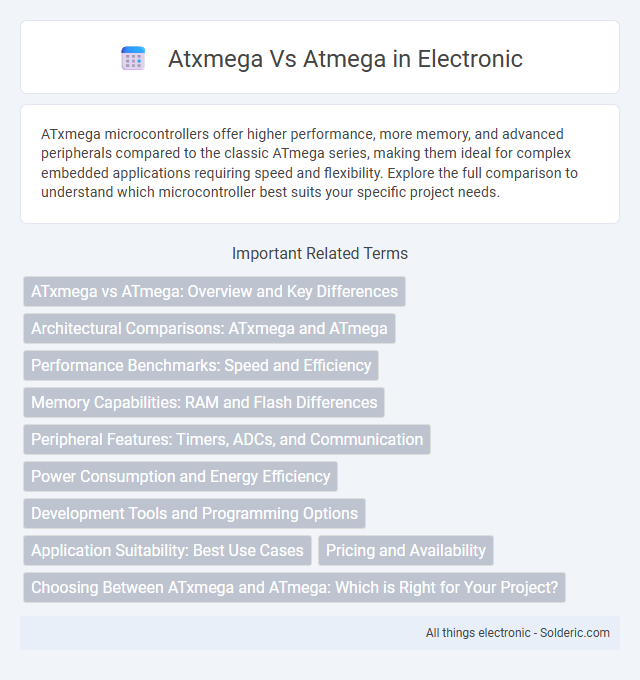ATxmega microcontrollers offer higher performance, more memory, and advanced peripherals compared to the classic ATmega series, making them ideal for complex embedded applications requiring speed and flexibility. Explore the full comparison to understand which microcontroller best suits your specific project needs.
Comparison Table
| Feature | ATxmega | ATmega |
|---|---|---|
| Core Architecture | AVR XMEGA 8/16-bit | AVR 8-bit |
| Operating Frequency | Up to 32 MHz | Up to 20 MHz |
| Flash Memory | Up to 384 KB | Up to 256 KB |
| RAM | Up to 16 KB | Up to 8 KB |
| EEPROM | Up to 4 KB | Up to 4 KB |
| ADC Resolution | 12-bit ADC | 10-bit ADC |
| DMA Controller | Yes | No |
| Peripheral Set | Advanced (DAC, Event System, Dual ADC) | Basic |
| Power Consumption | Lower in active/sleep modes | Higher comparatively |
| Applications | High-performance, low-power embedded systems | General-purpose embedded applications |
| Price | Higher | Lower |
ATxmega vs ATmega: Overview and Key Differences
ATxmega microcontrollers offer enhanced performance with higher clock speeds, increased memory capacity, and advanced peripherals compared to the traditional ATmega series. Key differences include ATxmega's 32-bit architecture and more sophisticated analog features, making them ideal for complex applications requiring precise signal processing. Your choice between ATxmega and ATmega depends on the need for processing power, memory size, and application complexity.
Architectural Comparisons: ATxmega and ATmega
ATxmega microcontrollers offer a more advanced architecture compared to ATmega, featuring higher clock speeds up to 32 MHz and enhanced peripherals like DMA controllers, event systems, and configurable logic units, which boost system efficiency and real-time performance. The ATxmega series also integrates more SRAM and Flash memory, supporting complex applications that demand faster processing and larger data handling capabilities. If your project requires robust multitasking and greater computational power, ATxmega's architecture provides a significant advantage over the traditional ATmega lineup.
Performance Benchmarks: Speed and Efficiency
ATxmega microcontrollers outperform ATmega series with higher clock speeds up to 32 MHz compared to ATmega's typical 20 MHz, enhancing processing speed and execution efficiency. The ATxmega's advanced architecture features increased SRAM, flash memory, and a 16-bit timer, enabling faster data handling and lower power consumption during intensive tasks. Benchmarks show ATxmega achieves up to 1.5 times greater throughput and improved efficiency in signal processing and real-time applications over ATmega variants.
Memory Capabilities: RAM and Flash Differences
ATxmega microcontrollers offer significantly larger RAM and Flash memory compared to traditional ATmega devices, with RAM sizes ranging up to 32KB and Flash memory up to 384KB versus ATmega's typical 2KB to 8KB RAM and up to 64KB Flash. This expanded memory capacity enables more complex program execution and data handling, ideal for applications requiring intensive processing or larger codebases. Your choice between ATxmega and ATmega should consider these memory differences to match the requirements of your embedded system project.
Peripheral Features: Timers, ADCs, and Communication
ATxmega microcontrollers offer more advanced peripheral features compared to ATmega, including multiple 16-bit timers with enhanced waveform generation capabilities versus the simpler 8-bit timers on ATmega. The ATxmega integrates higher resolution ADCs, typically 12-bit with differential inputs and faster sampling rates, while ATmega microcontrollers commonly feature 10-bit ADCs. Communication interfaces on ATxmega are more robust, including multiple USARTs, SPI, I2C, and support for high-speed USB, whereas ATmega provides more basic UART, SPI, and I2C options with limited high-speed or multi-channel capabilities.
Power Consumption and Energy Efficiency
ATxmega microcontrollers offer significantly lower power consumption compared to ATmega models due to advanced power-saving modes and more efficient peripheral designs. Their ultra-low power sleep modes and flexible clock system optimize energy efficiency, making them ideal for battery-powered and energy-sensitive applications. By choosing an ATxmega, your project benefits from extended battery life and reduced operational costs through smarter power management.
Development Tools and Programming Options
The ATxmega series offers advanced development tools such as Atmel Studio with extensive debugging capabilities and support for JTAG and PDI programming interfaces, enabling efficient in-circuit debugging and programming. In contrast, the ATmega series is compatible with simpler tools like AVR Studio and supports ISP and UPDI programming methods, which are suitable for basic development workflows. Both microcontroller families benefit from extensive community support and open-source toolchains like GCC AVR, but ATxmega's advanced peripherals often require more sophisticated programming options.
Application Suitability: Best Use Cases
ATxmega microcontrollers excel in complex applications requiring high processing power, extensive memory, and advanced peripherals such as DACs and high-resolution ADCs, making them ideal for audio processing, motor control, and precision instrumentation. Atmega microcontrollers are better suited for simpler tasks like basic robotics, embedded systems, and general-purpose microcontroller functions due to their lower power consumption and ease of use. Your choice between ATxmega and Atmega should prioritize the application's complexity and performance requirements to optimize efficiency and cost-effectiveness.
Pricing and Availability
ATxmega microcontrollers typically have higher pricing compared to Atmega variants due to their advanced features and enhanced performance capabilities. Availability of Atmega chips is more widespread globally, supported by extensive distribution networks and longer production runs. You may find Atmega MCUs easier to source and cost-effective for projects requiring basic to moderate processing power.
Choosing Between ATxmega and ATmega: Which is Right for Your Project?
Choosing between ATxmega and ATmega microcontrollers depends on project complexity and performance needs. ATxmega offers higher processing speeds up to 32 MHz, more memory with up to 384 KB flash, and enhanced features like DACs and advanced event systems, making it ideal for applications requiring real-time control and signal processing. ATmega microcontrollers provide a simpler architecture with lower power consumption and sufficient capabilities for basic tasks, making them suitable for cost-sensitive or less demanding embedded projects.
atxmega vs atmega Infographic

 solderic.com
solderic.com